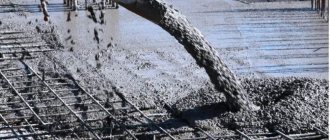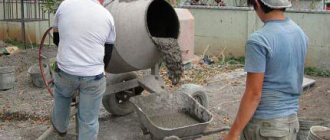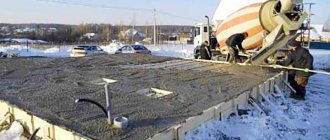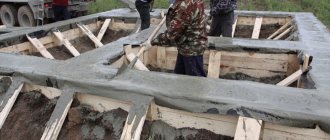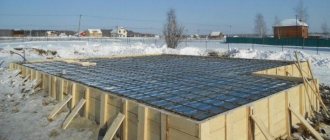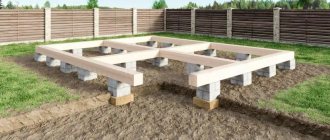Is it possible to pour the foundation in the fall? It is possible, but you need to take into account a number of factors, which you will read about in detail in this material. We will also look at when is the best time to pour a foundation and how to do it. The foundation must be strong and durable; autumn should not interfere with your construction. Autumn filling has its pros and cons. If you approach the work correctly, then at the end you can get a high-quality foundation that will not be inferior to the summer version. Gross mistakes can lead to the fact that instead of building load-bearing walls, you will have to remove defective concrete.
Features of autumn filling
Take these weather factors into account, and the foundation will be of high quality:
- Temperature. It is necessary to create an optimal regime - the cement mixture hardens best at 16-25 degrees. In summer, the temperature is much higher, which negatively affects the strength of the foundation. If the indicator is lower than optimal, the hardening will take longer, but it will not stop. The most destructive thing for concrete will be frosts, which occur even in September.
- Precipitation. The arrival of autumn is often accompanied by rainy weather. Excess liquid harms the material. Long rains can even wash away cement laitance, as a result, the grade of concrete decreases.
- Groundwater. This factor must first be taken into account by people planning to build in swampy areas. In September, the water level may be lower than in the warm season. Prolonged rains can completely interrupt construction, as groundwater fills the trenches.
- Humidity. Novice builders may think that this indicator negatively affects the hardening of the concrete mixture, but in fact the opposite is true - the concrete dries slowly. Accordingly, it becomes stronger. If the humidity outside is high, you won't need to humidify.
What to do in winter if you need to fill the foundation?
What should builders do in the winter? Especially for those who intend to construct the foundation with their own hands? After all, winter frosts are a real obstacle.
You can, of course, close the construction site until the frost subsides. Preserving the foundation for the winter is a completely effective and quite popular option. But situations are different.
Frost outside does not always begin exclusively in winter. Sometimes it begins in the fall and lasts for a long time, even after the onset of spring. In addition, as we noted above, a single frost is not as dangerous as temperature fluctuations themselves.
The foundation does not freeze in a day or two. In the best case, it is necessary that after pouring it, the temperature outside remains above zero for at least two weeks. And even after that you need to be careful.
High-quality greenhouse for concrete mortar
What should all those people do whose goal is to concrete the foundation of a bathhouse, a private house or any other structure? Do not postpone construction for an indefinite period.
Fortunately, modern technologies used in concreting foundations make it possible to work efficiently and efficiently even after the onset of real frost.
There are such solutions to the problem of sub-zero temperatures:
- Adding plasticizers and more cement.
- Warming up the concrete.
- Construction and installation of greenhouses.
Each option provides its own temperature regime and its own approach. The first option is the simplest, the last is the most difficult. The construction and installation of greenhouses takes a lot of time and effort, but in some situations it is worth it.
We will consider these methods using the example of building a bathhouse. Baths are very often erected in winter, since the structure is small and its installation causes a minimum of inconvenience, even if you work exclusively with your own hands. The structure of the bathhouse is most often placed on a strip foundation, which has its advantages. But it also happens differently when the walls of the bathhouse are mounted on piles, using a pile screw foundation as a supporting structure. We will also mention him.
Improving the quality of the solution
The simplest solution is to improve the concrete solution. Not the cheapest, of course, but believe me, compared to other options, you will definitely win.
The advantages of this approach are obvious. The minimum labor intensity of the process of strengthening the structure comes down to adding more cement, purchasing premium grade cement, frost-resistant cement, etc.
The more cement, the faster the solution sets and the faster it cools. If there is no constant winter temperature outside, or it fluctuates, sometimes rising from +5 degrees, then dropping to slight minuses, then this solution will suffice.
The concrete will set even at the moment of pouring; then it is enough to cover it with a cloth and leave it overnight . In most cases this is more than enough. All the processes under consideration can and should be done with your own hands.
Electrodes for heating the foundation strip
An equally useful method is the addition of plasticizers. Plasticizers are special chemicals that perform a variety of tasks. With their help, natural waterproofing of the foundation is carried out in winter, strengthening it and speeding up work processes.
The brands of frost-resistant cement that are common on the market today consist of approximately 10% plasticizers.
The option of increasing the frost resistance of the solution is good when the cold winter season has not yet fully arrived. In real frosts such decisions are of little use.
Warming up the concrete
Warming up concrete involves a slightly different method of action. Here you will need a heating unit that runs on electricity. Special electrodes are immersed in uncured strip or pile foundations (the installation is generally used in any reinforced concrete structures, with the exception of installation of screw piles), and then they are heated.
Heating the electrodes increases the temperature inside the concrete and keeps it at an acceptable level for as long as you need.
High-quality heating is expensive. The installation itself costs money, heating the concrete requires a large amount of electricity, the workers also need to be paid, and you cannot complete the work with your own hands.
However, heating with electrodes makes it possible to do its job even in winter, when there are hard minuses outside and installation of structures by other means is impossible. Even after overcoming the critical point, heating the concrete mixture remains quite effective.
An example of assembling a foundation in winter (video)
Assembly of the greenhouse
When pouring massive structures, for example, forming a strip foundation for a large private house, it is recommended to make something like a greenhouse for concrete.
Builders call greenhouses for mortar greenhouses, and the process itself is referred to as installation of greenhouses.
The design of greenhouses is very similar to the design of a conventional greenhouse for vegetables. Except that the surface of the greenhouses is stronger, the frame is more reliable, and it weighs much more than a standard greenhouse.
Installation of greenhouses is an expensive business. We do not recommend doing it with your own hands, unless you are going to pour the foundation for a bathhouse or any other small building.
Alternative option: using a pile foundation
An alternative to all these solutions will probably be the installation of foundations from screw piles. Installation of screw piles differs from pouring a standard foundation for several reasons.
For screw piles, if anything is needed, it is a minimal amount of mortar, and even that cools quickly. The load-bearing capacity of screw piles is not too large, but for the installation of the same bathhouse it is more than enough.
Installation of screw piles is carried out in any type of soil, even frozen. Installation of screw piles is carried out quite quickly - you can install the walls of a bathhouse on a frame of piles in a matter of days. That is, it’s enough to just catch a favorable moment and start intensively installing screw rods, and then plant a bath on them and the job is done.
The same process when pouring a monolith without using screw piles would take you at least a week of active work and another month of waiting.
The right time of year
It is necessary to think through construction in order to take advantage of the benefits of the autumn period. If you ask a professional builder what time of year is best to pour the foundation, he will answer you - in early autumn or spring. Two conditions must be met - warm weather and high humidity. Concrete takes about 25-30 days to gain the required strength.
In the first months of autumn, frosts occur, but quite rarely. If necessary, the structure can always be protected from low temperatures. As for groundwater and precipitation, they are not so dangerous for the foundation, since excess liquid can cause serious damage to the foundation only in the first days after pouring. The mixture sets in 24-40 hours, after which the concrete gains strength.
When is it better to build an underground part of a building?
The best time to start pouring the foundation is early or mid-August. This choice is justified by the need to begin laying walls after installing the underground structure of the buildings. Having completed the concrete work, you can now begin building walls and installing floors.
If you plan to continue construction work after the end of winter, you can safely procrastinate until the end of September. But remember that concrete needs 28 days for final hardening and strength gain, and at low temperatures this time increases significantly.
Those who decide to pour a foundation in the fall need to know that the underground structure requires special wintering conditions. For example, the tape version of the design assumes the absence of any protection, since it independently withstands harsh conditions. But this does not apply to the shallow strip foundation of the building, which requires additional load from above, otherwise the heaving of the soil will push the installed structure upward. Preservation of a solid slab version of the building's base for the winter is prohibited, because heaving forces can tear the slabs. Pile and columnar structures are considered the most undemanding. They survive the winter better than others.
From all of the above it follows that it is possible to pour the foundation in the autumn. It is only important to follow the recommendations, then the foundation will serve as a high-quality foundation for the building and correctly transfer loads to the ground.
The period lasts several hours after preparing the solution. At this stage, you need to have time to complete the following processes:
- Transportation of the solution to the work site. This is especially true when ordering pre-fabricated concrete, since the production site may be located at a sufficient distance from the area where the foundation needs to be poured. The issue is solved by using special equipment - concrete mixers. Constant stirring increases the life of the solution.
- Laying the concrete mixture into the mold.
- Compaction (vibrating or pinning) and leveling.
The setting time depends on the ambient temperature, which is why it is so important to decide when it is best to pour the foundation for a house. To select the appropriate time, it is recommended that you familiarize yourself with the following table.
| Ambient air temperature (average daily value indicated), ᵒС | The period during which setting occurs (on average), the beginning and end of the process are indicated in hours |
| 30 | 1-2 |
| 20 | 2-3 |
| 6-20 |
Hardening
Immediately after setting is completed, hardening begins. This is the name given to the process of crystallization of concrete mortar and its transformation into artificial stone. Knowing the hardening time is necessary in order to understand when it is better to start removing the formwork from the foundation of the house and engage in further construction processes. An important task for builders is to reduce the duration of work without compromising quality. This can only be done by studying the regulatory documentation.
The most important characteristic of a concrete mixture is its grade strength. Due to the introduction of a new designation for this value, confusion in the labeling is possible. It all depends on what GOST the plant operates on. If the marking is carried out in accordance with GOST 26633-2012, then we are talking about concrete strength classes, which are designated by the letter B, for example B20. The number is the grade strength in MPa. When using markings in accordance with GOST 26633-91 * (an outdated document that is still used by some specialists), strength is indicated by a brand, for example M300, where 300 is the value in kgf/m².
You can remove the formwork from the foundation of the house and start building walls only when the concrete has gained strength of at least 70% of the original grade. This requirement is given in the joint venture “Load-bearing and enclosing structures”. It is better to comply with these conditions, but if there are justifications, you can remove the formwork when the strength gain is more than 50%.
Protection from precipitation and frost
Monitoring precipitation is quite simple: follow the weather forecast and choose days for pouring when no rain is expected. There must be at least three days in reserve. If precipitation takes you by surprise, you need to quickly cover the “ribbons” with oilcloth. It is more difficult to protect from frost, and the procedure will be expensive. Some people prefer to simply cover the base - this is a cheap and ineffective way. Next come special anti-frost additives. If you buy high-quality additives, concrete will normally gain strength even at -15 degrees.
This table will help you choose the appropriate curing time for the concrete mixture.
The best option is to provide the concrete with good heating. Today, a special cable is used for these purposes. It must be placed on top of concrete and covered with heat-insulating material. It is not possible to carry out this procedure on your own, since specialists must calculate the power consumption, suitable length and other parameters. And you can’t overheat the mixture.
General rules to follow
Let's start with the fact that everyone who wants to know whether it is possible to fill the foundation in parts in winter conditions will probably be disappointed with the answer. A definite no. And until the filling is completed you will have to work around the clock. Laying should be done in segments that are small in height and length, immediately covering them with the next layer to avoid temperature loss. If for some unforeseen reason a helium shell begins to form on the surface of the poured concrete, it must be chipped off.
It is important to properly prepare the object for pouring:
- clear the pit or trench of snow, chip and remove ice from the bottom and from the reinforcement. To prevent freezing and icing of the bottom, you need to cover the trench or foundation pit with straw immediately after digging and laying the sand cushion;
- warm the bottom between the walls of the formwork approximately 30 cm. Do not pour concrete on top of frozen soil! Thawing under the mass of the solution, the soil will settle. It is not a fact that the settlement will be uniform. Moreover, there is no certainty that the foundation will not sag too much;
- provide access to the formwork from all sides.
There are few rules for safe, effective concrete pouring in winter, but they must be strictly followed. It is much easier to be diligent before pouring and during the process than to waste time and money on dismantling and alterations.
Rules for pouring in cold weather
One of the SNiP points contains information about laying the foundation in cold weather. Below are important excerpts from these rules:
- If the temperature outside is low, mix indoors. The ideal temperature for kneading is 20-25 degrees. As an alternative, heated mixers can be used. So, you already know at what temperature you can pour the foundation in the fall.
- Use heated mixtures, fillers and water. Pieces of ice or lumps will ruin the entire solution, so make sure that all liquids are at the right temperature. The water should not be colder than 70 degrees.
- The lower the temperature, the longer it takes to mix the concrete. If we take autumn, then the process should last ¼ longer than in summer.
- If there have been recent frosts, then it is necessary to check the formwork and soil before pouring. They shouldn't be frozen. If you ignore this, the mixture will also freeze. It is better to wait until the soil and formwork “even out” in temperature.
- It is worth taking care of the reinforcement frame. Warm it up so that frozen areas of the solution do not form around the rods.
- Increase the vibration pressing time by ¼ compared to the warm period.
- If frost occurs, you should check whether the concrete has gained strength of 5 MPa or more. This did not happen? Then you should take care of warming up the base.
How to fill it correctly?
Low temperatures dictate their own rules for pouring. For large depths and widths, it is advisable to pour continuously using a special vibrator. This option will allow you to obtain a homogeneous dense mass after hardening.
Advice from the experts:
- the water for the solution should be heated to +70 degrees;
- mandatory use of plasticizers and frost-resistant additives;
- cement grade not lower than M500;
- It is advisable to do the kneading in a heated room;
- the mixer must be equipped with a heating system;
- mixing time increased by 20%;
- heat-insulating material is placed at the bottom of the trench;
- install easily removable formwork, inside which mineral wool is placed. It should be at least 10cm higher than the base body.
Is it possible to concrete during night frosts - it is possible, taking precautions and mandatory insulation.
Recommendations from professionals: pour concrete in the fall
If you decide to carry out construction work in the fall, you should consider the following factors:
- Antifreeze additives will definitely not harm the concrete mixture, and you can be safe from sudden frosts. Residents of the CIS probably know that even relatively warm regions are not immune from a sharp drop in temperature.
- Alternating thawing and freezing are the worst conditions for concrete to harden. You shouldn’t do the work when the temperature is above zero during the day and below zero at night. That is why professionals recommend filling in mid-spring (April, early May) or in the first months of autumn.
The table shows the percentage of strength and the effect of temperature on this process
Is it advisable to leave the foundation unloaded for the winter?
Wintering the foundation
Is it advisable to leave the foundation unloaded for the winter?
If for some reason you only installed the foundation in one season, then, as a rule, the question arises: “Is it possible to leave it for the winter without load, i.e. without walls and roof?
It is worth noting right away that it is strictly not recommended to leave any foundation to “settle” over the winter. The bearing capacity of the foundation is initially calculated based on previously conducted geological surveys and implies the construction of walls and roofs immediately after installation of the foundation.
But if such a situation does arise, then some factors should be taken into account in this matter. One of which is soil heaving in the winter season - an increase in the volume of soil caused by freezing of the groundwater with which it is saturated. The second is the type of foundation itself, which it was decided to design based on the results of geological surveys.
Pile foundations
In fact, screw piles twisted below the soil freezing depth are not in danger. The auger at the end of the pipe reliably keeps the pile from being squeezed out during the winter. The above-ground parts of the piles are coated with paint, which protects them from corrosion. As a rule, a metal platform is welded to the top of the pipe, thanks to which water will not get inside the pipe.
The same situation applies to bored foundations of the TISE* type.
A foundation made of simple bored piles should absolutely not be left to “winter” without load, since the soil can squeeze it out due to frost heaving, even if they are buried below the freezing point of the soil. Even if a reinforced concrete grillage is made on piles, it can move and cracks can form on its surface.
How does concrete hydrate?
People are often interested in when it is possible to pour the foundation in the fall, and whether it is even worth doing it at such an unpredictable time of year. Now let’s look at how concrete hardens in order to better understand all the processes and plan construction accordingly:
- at the initial stage, a crust appears on the surface of the mixture; it is sodium hydrosilicate;
- after this, the harder particles of the foundation surface harden;
- the next stage of solidification is contraction of the shell due to evaporation of the liquid;
- this process begins to move towards the center until the mixture acquires the stated strength.
Based on this diagram and answering the question whether it is possible to pour the foundation in October, experienced builders confidently say: “It is possible!” And we will describe why, comparing this process in summer and autumn-winter.
When is the best time to decorate your home?
You can start finishing the house right away, but it is advisable to give a little time for the house to settle. You can begin finishing work as soon as the weather warms up, which will allow you to move into the house safely in the summer.
The house can be finished in the spring of next year.
It must be taken into account that winter construction requires professional specialists. If you start finishing without waiting for the end of winter, it is likely that you will have to spend extra money and effort.
Comparison of concrete poured in the heat and in the fall
It is logical that in the summer heat the foundation will dry out many times faster. But will its structure become as dense as necessary? After all, the whole house depends on this - how long it will last, whether cracks will appear in its walls. Rapid hardening occurs due to the rapid evaporation of water. However, this is not very good, because voids are formed instead, which make the concrete brittle.
In the fall, pouring the foundation—in October, for example—may be complicated by the onset of frost. As a result, the water crystallizes, and voids are formed due to the fact that ice forms in the mixture, which also expands, creating microcracks. That is why the foundation is poured in the cold season using special technologies.
How to choose wood for construction
Let's assume that you need to build a house from timber or logs of natural moisture. In most cases, such building material is prepared in winter, which is another significant advantage of winter construction. In winter, the movement of sap in the wood stops, the timber becomes drier, which is why the wood is subject to less deformation.
If desired, the wood can be coated with antiseptics to minimize the risk of mold occurrence and development. In winter, conditions are not entirely suitable for the formation of mold, since the fungus can only develop in warm conditions. Thus, in winter, the risk of mold in wood, especially treated with special compounds, is reduced to almost zero.
Properties of concrete that benefit builders
When the mixture hardens, a chemical reaction occurs that causes heat. Thanks to this, the concrete dries better, but due to the fact that the ambient temperature is low, no voids are formed in it and it does not dry out. Therefore, the answer to the question whether it is possible to pour the foundation in the fall is unequivocal: yes. The most important thing in this matter is to carefully calculate everything. In addition, pouring concrete must be included in the construction plan; this will allow all the necessary materials, equipment and fixtures to be prepared in advance.
In cold weather it is better not to flood the pillars unless they are sufficiently insulated. Indeed, in such conditions, internal heat will be enough for a very short period of time, during which it will not have time to completely harden. It is better to limit yourself to only a low foundation, in which case the chemical reaction can continue and dry the solution much longer.
Pouring the foundation in separate sections
Many developers are interested in the question of whether it is possible to fill the foundation in parts, since it is not always possible to prepare concrete in such quantities that it is enough to fill the entire formwork.
Let's see what SNiP says about this . The best method of installation, according to building regulations, is concreting in horizontal layers without interruptions.
If the volume of the foundation is large and does not allow laying in a continuous layer, then laying in inclined layers is allowed. In this case, the length of the joint on which fresh concrete will be laid must be at least 1.5 meters, and its slope no more than 30 degrees.
When pouring the foundation layer by layer, it is important to follow one more rule. Fresh concrete must be laid on the top layer before it sets to ensure the solidity of the entire structure.
If several days have passed after pouring and the concrete has hardened, before laying fresh concrete mixture it must not only be rinsed well with water, but also the cement film must be removed from the surface. It forms the interface along which the foundation fails under load.
Concrete hardening factors
Often, in order to have time to build a house in the spring and summer, the owners are always interested in whether it is possible to pour the foundation in October, so that in the spring, when it gets warmer, they can immediately begin building the house. After all, when the foundation is ready, construction will go much faster. And this is especially important when the building is planned to be large, and there is a risk of not having time to rebuild it before the next cold weather.
The quality of concrete is influenced by the following factors:
- volumes and dimensions of the structure;
- proportions of fill elements;
- quality of cement and its grinding;
- climate;
- possibilities for heating and insulating concrete.
In order for the cement to react faster, it needs to be ground as finely as possible, then pouring the foundation in October will be of much better quality, because voids will not form in it. Only the aggregates and water need to be heated. Under no circumstances should this be done with cement, because it will lose the properties that are necessary for a high-quality foundation. But this is very undesirable.
Construction of a private house in autumn
It's no secret that it is impossible to build a country house in just a few months. Unforeseen difficulties often arise that can stall the process for a long time. Even if construction of a cottage began in the spring, it is unlikely that everything will be completed in time for the winter cold. Well, if you are starting to build a house in the fall, then you definitely need to adhere to special rules for carrying out work in order to avoid many troubles in the future.
Solving the problem of concrete freezing
The next insurmountable problem for builders of past years was that in frost, concrete loses its qualities, becoming brittle. This happens because its components do not mix under such conditions due to crystallization of water due to exposure to frost. Therefore, pouring the foundation in the fall, and even more so in winter, was something unrealistic.
Now everything is solved with the help of chemical additives that prevent water from freezing. In addition, special concrete is sold, which already contains substances that promote its normal hardening at sub-zero temperatures. Its properties are no different from its summer counterpart.
However, there is an opinion that it is undesirable to use chemical additives in the concrete of a residential building, because many of them are poisonous. Therefore, when constructing a building, you need to take this nuance into account.
Also, to pour the foundation, in October or February, it doesn’t matter, salt is added to the solution. Its content should not exceed 2%; it does not allow water to harden. Accordingly, all ingredients are fully mixed and frozen. Without heating, this method can be used down to -5 ° C, and if the temperature drops even lower, then it is worth using heating, which will be discussed later.
You can also make the solution not subject to freezing using acid additives. They are added, after which a chemical reaction occurs in the mixture, which increases the temperature. Under this influence, the concrete dries out. And, of course, in severe frosts, the foundation should be additionally covered so that the generated heat does not immediately evaporate.
Precautions during construction in the fall
If your goal is to lay a foundation during the fall cold, there are a few safety precautions you should take into account before you begin.
A set of measures to protect the foundation from frost and dampness:
- It is necessary to add protective components to the concrete composition that can maintain optimal temperature conditions for high-quality drying.
- Installation of special formwork.
- Heating using cable and infrared lamps.
Pros of winter construction
- In winter, the demand for materials decreases significantly, which allows for significant savings.
- In winter it will be much easier to get to the dacha, since there are almost no traffic jams.
Disadvantages of winter construction
- If the house will be built in winter, then a heated change house for builders will definitely be required. It is advisable to build a small but reliable stove in the summer, rather than using a weak “potbelly stove” for heating. In addition, you need to purchase a supply of firewood or another type of fuel for the stove.
Wooden shed for builders
- If there is electricity on the site, then you will need to take care of the reliability of the electrical wiring and heating elements.
- Naturally, people need to eat something, so you need to equip a gas stove and several gas cylinders.
- There may be problems with the foundation. Ideally, it is recommended to lay out the foundation in the fall, when the “dacha” season has already ended and frosts have not yet struck. Building a foundation is difficult, but quick, especially if it is possible to fill it with ready-made concrete. As practice shows, it is fast and much cheaper.
Foundation insulation
When building a foundation in the fall, another method can be used to protect against low temperatures. Nothing is added to the concrete, its consistency remains the same as in the summer, only the foundation is insulated. This can be done with different materials. Mainly used:
In general, you can use any available material. In severe frosts, the foundation is even covered with sawdust, which perfectly protects from sub-zero temperatures. The main thing is that the top layer is waterproof and can protect against precipitation. In addition, you need to make a slope so that the water does not remain on the material, but goes sideways from the foundation. In general, it’s worth doing everything in the form of an awning, it will be more convenient.
The question often arises about whether it is possible to fill the foundation in the fall, also because there is a lot of dampness around, in addition to frost. This can also be solved very easily: a heat gun is directed under an awning made of polyethylene, roofing felt or tarpaulin. It drives warm air inside, heating the solution and promoting the evaporation of moisture. This way you can easily dry the foundation even in January frosts.
Quite often, in places filled with concrete, greenhouses made of polyethylene are installed, inside which a heater or heat gun is placed.
Important rules for building a house in the fall
When building a house in the fall, several important rules must be followed.
- At a temperature of -25 degrees, wood can become brittle, so working with such wood is not very convenient, especially when it comes to cutting down cups.
- If the winter is expected to be cold, it is recommended to build the house from a ready-made construction kit, which is assembled right on site.
- In addition, you should prepare in advance for the fact that a construction company may refuse to work at temperatures below -20 degrees.
- There are also significant restrictions regarding roofing materials. There are not many restrictions, and they will mainly concern the roofing, in the manufacture of which bitumen was used. Packages with roofing must be stored in a warm room. It is not advisable to lay tiles at temperatures ranging from -10 degrees or -15 degrees.
Return to contents
Electric foundation drying
There is another great way to dry out the foundation. When pouring it, a wire is placed in the solution. It can be copper, steel or aluminum. On one side, all ends are divided into two bundles; they will be connected to the welding machine. Light bulbs are connected to the other side, two ends to each. The lamps must be 36 V, the most important thing is that everything needs to be connected correctly. If there is an error somewhere, then nothing will work. Next, the wires are connected to the lamps in pairs and connected to the device. The first ones should light up, at first with a dim light, but as the concrete begins to dry out, they will burn brighter and brighter. This way you can perfectly monitor the progress of the entire operation and know when the foundation is ready. This method is also suitable for heating the foundation in October or other cold months.
Many builders generally prefer pouring concrete in the fall, because it does not dry out, as happens in the summer heat. The pouring method, or more precisely, the method of retaining heat in the mixture, must be chosen based on weather conditions, available equipment and materials.
Preparation of concrete mixture
The concrete solution has the following characteristics:
- mobility (rigid, mobile, cast), the higher it is, the faster and tighter it fits. At the same time, the amount of cement increases;
- crushed stone fraction, the finer it is, the denser the compaction;
- type of aggregate - crushed stone, gravel, recycled stone, various types of sand.
You should begin working with the solution immediately after kneading, as soon as the mass becomes uniform in consistency and color. If the concrete is delivered by mixer, the trench must be fully prepared for pouring it, with a cushion of thermal fabric if necessary. Also, there must be the required number of workers with tools at the site.
Is it possible to make a poured foundation in the fall?
Let us immediately make a reservation that experts have differing opinions on this matter. Some say that moisture and frost will not allow the concrete to harden properly, and as a result, its debris will have to be removed in the spring. Others argue that it is only in the fall that it is worth laying the foundation, because... in the cold it hardens more slowly, and therefore shrinks better and more tightly, which will protect against possible cracks and deformations under load. Yes, the air humidity is higher, but the poured foundation will not have to be constantly moistened, which has a positive effect on its quality. In addition, by autumn the groundwater level is lower than in winter and spring. But in the spring you will just have to wait until the level drops (do not pour concrete into a pit with liquid mud), and then, you see, summer is in full swing - there are no workers and transport, building materials are at astronomical prices, and even then it will be possible to start masonry, summer will end.
To pour or not to pour is up to you. We will only talk a little about the features of the process, the pros and cons. So, you are determined to pour the foundation in November. What do you need to consider?
Is it possible to carry out construction in cold weather?
Is it possible to pour the foundation in winter? In late autumn (November) and winter (December, January, February), when subzero air temperatures are observed throughout almost the entire territory of the Russian Federation, it is impossible to fill the foundation without taking special measures. It is important to solve two main problems: ensuring and accelerating the hydration process, as well as preventing water from freezing.
If construction is carried out on a budget basis using ordinary concrete without special additives and the absence of specific measures, then it is better to “freeze” the construction of the foundation in the period from November to March (central regions of the Russian Federation) and mothball the construction site .
The nuances of using cement mortar in spring
Builders with experience claim that by starting the construction of the foundation in early spring, there is a chance by the last month of autumn to complete the first stage of building a house under the roof and begin to insulate it for the winter.
They start pouring concrete in the spring, hoping that construction work will be completed faster
Frosts in spring, characterized by a constant drop in temperature below zero, irreversibly change the properties of concrete for the worse. In order for the characteristics of the cement mortar to remain the same, it is recommended to add antifreeze agents to it.
It would not be a bad idea to postpone the work of pouring the foundation until that period of spring, when the weather becomes consistently warm. Usually, already at the end of March, the thermometer shows above-zero temperatures every day.
To pour concrete in the spring, you will have to wait for warm days
In the spring, if you plan to pour the foundation, you may encounter problems such as:
- groundwater, which will not interfere with the implementation of the plan only if it is diverted from the foundation of the house;
- unsuitable cement mortar, which happens when the builder wants to save on materials, despite difficult conditions.
Filling an armored belt at sub-zero temperatures
The reinforcing belt is designed to evenly distribute the load from the upper rows of masonry to the lower ones. It seems to connect the entire structure into a single whole. which significantly increases its overall strength and durability. The armored belt is made from steel rods laid around the perimeter, which must be welded together into a single structure.
When constructing a structure from gas silicate blocks, a reinforced belt is especially important. Such blocks quickly crack at the slightest movement of the soil or during shrinkage of the base. When installing a roof on such blocks, an armored belt is also necessary, since it is impossible to attach the timber to the blocks - they can crack. To avoid deformation of the walls and the building as a whole, a welded reinforced belt is simply necessary. It is welded into a solid structure, laid on top of the masonry and filled with concrete. It is sealed with mortar on both sides so as not to disturb the thermal insulation of the walls. Concreting of the belt is allowed in the cold season only using the above methods.
Working with concrete mixture at low temperatures is allowed in cases where there is no other option, because the optimal hardening temperature of the mass is from +5 degrees to 25.
- Sand Quarry sand
- Seeded sand
- Washed sand
- river sand
- Quartz sand
- PGS – sand and gravel mixture
- Sandy soil
- Sand in bags
- Coarse sand
- Sand medium
- Medium construction sand
- Fine sand
- Construction sand
- Construction sand in bags
- Natural sand for construction work
- Sand for children's sandboxes
- Sand in bags 50 kg
- Sand in bags 25 kg
- Sand in big bags
- Granite crushed stone Granite screening fraction 0-5 mm
- Crushed gravel fraction 5-10 mm
- Crushed limestone 5-20 mm
- Gravel 3-10
- Brick fight
- Expanded clay 0-5
- Fertile soil
- Technical salt
- Soil removal
- Snow removal
- Snow removal
- Removal of construction waste
- Development of pits
- Price list
- Guest standards and certificates
- Sample contract
- Customer Reviews
Dismantling of formwork depending on external conditions and load on the building
To reduce evaporation, concrete is covered with film on the second day after pouring.
Despite its strength in finished form, concrete needs maintenance almost immediately after pouring and throughout the entire maturation period. At the end of this process, the mortar must be leveled, the strength of the form must be checked and, if necessary, corrected. Then the structure should be fenced to prevent mechanical damage. After a day, the foundation should be covered with film - this will prevent the rapid evaporation of water from its surface. Already on the third day, you need to start watering the concrete. The higher the air temperature, the more often.
One of the criteria that influences the timing of formwork removal is the calculated load that will be exerted on the support system.
The following minimum standards are defined for various buildings:
- frame houses - 50%;
- buildings made of foam blocks - 60%;
- construction made of oak logs - 70%;
- brick mansion - 80%.
Weather conditions have no less influence on the timing of formwork removal. In the cold, concrete matures very slowly, sometimes taking up to two months. In the heat, the mixture completely hardens by the end of the third week. The fact that the panels can be removed is indicated by the formation of cracks between them and the strip foundation.
